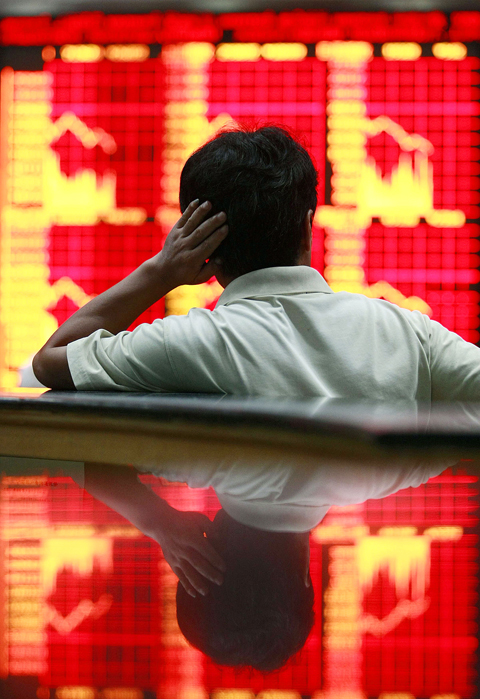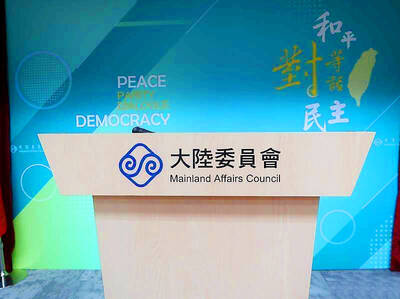Crude prices slid further in Asian trade yesterday as markets reacted to falling consumer confidence in the US, analysts said.
New York’s main futures contract, light sweet crude for delivery next month, was down US$1.01 to US$66.50 a barrel in afternoon trade from its close on Friday.
Brent North Sea crude for October delivery fell US$0.79 to US$70.65.

PHOTO: REUTERS
Prices continued moving downwards as data released by the University of Michigan on Friday showed an unexpected fall in consumer sentiment, which spooked the commodities and equities markets, analysts said.
“The report showed a drop in consumer confidence and that weighed on the oil market. The oil market was also pressured by the falling stock markets,” said Victor Shum, senior principal of Purvin and Gertz energy consultants in Singapore.
The report said that its consumer sentiment index dipped to a preliminary 63.2 from 66 this month, confounding most analysts who had expected it to rise to 69 and raising further red flags on consumer spending, the main driver of the US economy.
Shum said weak oil fundamentals would continue to put a peg on crude prices.
“Given the very weak oil market fundamentals, the mid-60s to high-60s is about the right range. The path of least resistance is down,” he said.
Crude oil may drop to test a support line around US$63 a barrel in New York should it fail to reach two key targets above US$74, a technical analysis by Commerzbank AG said.
Oil has failed to re-attain this year’s high of US$73.23 a barrel reached on June 11. A fresh rally will be capped in a range between US$74.54, the 200-week moving average, and US$76.28, a critical level using so-called Fibonacci analysis, Commerzbank said.
Failure to breach these points may send crude plunging toward a support line connecting the lowest prices of the past six months, the bank said.
“We would allow for probes into this key overhead resistance band, but would again allow for initial failure,” Commerzbank analyst Karen Jones said in a report on Sunday. “Failure here would once again cast attention back to support offered by the six-month uptrend.”
Crude futures for delivery next month traded around US$70 a barrel on the New York Mercantile Exchange last week. The six-month trend-line indicates oil would be supported against further losses at US$62.94 a barrel, the bank said.
“A close above the US$76.28 resistance would be significant as this would imply resumption of the longer term bull move to US$90,” Jones said, adding that this scenario was “not favored” in her estimates.
A level of US$76.28 a barrel corresponds to a 38.2 percent retracement of oil’s collapse from its record of US$147.27 in July last year to US$32.40 in December. The significance of this 38.2 percent move comes from the ratios between numbers in the Fibonacci sequence, used by traders to predict points of resistance and support.

MORE VISITORS: The Tourism Administration said that it is seeing positive prospects in its efforts to expand the tourism market in North America and Europe Taiwan has been ranked as the cheapest place in the world to travel to this year, based on a list recommended by NerdWallet. The San Francisco-based personal finance company said that Taiwan topped the list of 16 nations it chose for budget travelers because US tourists do not need visas and travelers can easily have a good meal for less than US$10. A bus ride in Taipei costs just under US$0.50, while subway rides start at US$0.60, the firm said, adding that public transportation in Taiwan is easy to navigate. The firm also called Taiwan a “food lover’s paradise,” citing inexpensive breakfast stalls

TRADE: A mandatory declaration of origin for manufactured goods bound for the US is to take effect on May 7 to block China from exploiting Taiwan’s trade channels All products manufactured in Taiwan and exported to the US must include a signed declaration of origin starting on May 7, the Bureau of Foreign Trade announced yesterday. US President Donald Trump on April 2 imposed a 32 percent tariff on imports from Taiwan, but one week later announced a 90-day pause on its implementation. However, a universal 10 percent tariff was immediately applied to most imports from around the world. On April 12, the Trump administration further exempted computers, smartphones and semiconductors from the new tariffs. In response, President William Lai’s (賴清德) administration has introduced a series of countermeasures to support affected

CROSS-STRAIT: The vast majority of Taiwanese support maintaining the ‘status quo,’ while concern is rising about Beijing’s influence operations More than eight out of 10 Taiwanese reject Beijing’s “one country, two systems” framework for cross-strait relations, according to a survey released by the Mainland Affairs Council (MAC) on Thursday. The MAC’s latest quarterly survey found that 84.4 percent of respondents opposed Beijing’s “one country, two systems” formula for handling cross-strait relations — a figure consistent with past polling. Over the past three years, opposition to the framework has remained high, ranging from a low of 83.6 percent in April 2023 to a peak of 89.6 percent in April last year. In the most recent poll, 82.5 percent also rejected China’s

PLUGGING HOLES: The amendments would bring the legislation in line with systems found in other countries such as Japan and the US, Legislator Chen Kuan-ting said Democratic Progressive Party (DPP) Legislator Chen Kuan-ting (陳冠廷) has proposed amending national security legislation amid a spate of espionage cases. Potential gaps in security vetting procedures for personnel with access to sensitive information prompted him to propose the amendments, which would introduce changes to Article 14 of the Classified National Security Information Protection Act (國家機密保護法), Chen said yesterday. The proposal, which aims to enhance interagency vetting procedures and reduce the risk of classified information leaks, would establish a comprehensive security clearance system in Taiwan, he said. The amendment would require character and loyalty checks for civil servants and intelligence personnel prior to